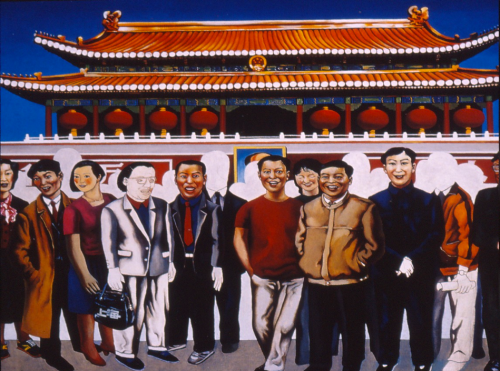Tiananmen Gate Painting #1 Dong Xiwen, The Founding of the Nation, 1952. This painting is of Ma
Tiananmen Gate Painting #1 Dong Xiwen, The Founding of the Nation, 1952. This painting is of Mao’s first address to the people in 1949. Painting #2 Sun Zixi, In Front of Tiananmen, 1964. In this painting the “types” of Chinese citizens visit Tiananmen. Mao’s portrait is of central focus. Painting #3 Wang Jinsong, Taking a Picture in Front of Tiananmen, 1990. Just of 40 years later “type" of Chinese citizens visit Tiananmen. Now however, Mao’s presence is obscured and less important. What’s interesting is the site and its function are almost unchanged. Gates and walls were two principal features of a capital in traditional China because they both shaped a city and made it meaningful. Without much difficulty historians have traced this design back to China’s antiquity. Although such an unbroken tradition in city planning may be admirable, one wonders why a culture would so insistently reject any fundamental change. In particular, what did these gates and walls mean and why did they become an imperial obsession? Perhaps the only logical explanation for this obsession was a political tenet that power could be maintained only by keeping it secret. The walls were layers of barriers that repeatedly separated the "inner” from the “outer” and the gates led to (but did not display) something deep inside the labyrinth. The “thing” concealed behind the walls and gates was precisely the emperor. “The Way of the ruler lies in what cannot be seen, its function in what cannot be known. Be empty, still, and idle, and from your place of darkness observe the defects of others. See but do not appear to see; listen but do not seem to listen; know but do not let it be known that you know …. Hide your tracks, conceal your sources, so that your subordi-nates cannot trace the springs of your action. Discard wisdom, forswear ability, so that your subordinates cannot guess what you are about. Stick to your objective and examine the results to see how they match; take hold of the handles of government carefully and grip them tightly. Destroy all hope, smash all intention of wresting them from you, allow no man to covet them.” This old architectural symbolism, however, collapsed (at least on the surface) when Mao appeared above Tiananmen on 1 October 1949. To the thousands gathered outside the gate, it meant that the hidden power had finally emerged and submitted itself to them. No other gesture could more effectively prove the newness of the Communist leadership, and no other act could more convincingly seal the title of People’s Republic. To become a monument, Tiananmen had to be isolated and extracted from its traditional context. This process first took place on a symbolic level: after 1949 the Gate became an emblem. Once the building stood as an individual entity, its monumental form became analogous with the new ruling power and ruling figure. Both the Gate and Chairman Mao were primary symbols of new China, they were naturally equated. A huge portrait of Mao was installed on the Gate and was updated year after year. -- source link
Tumblr Blog : teenagesmog.tumblr.com
#chinese art#socialist realism#modern art#contemporary art


